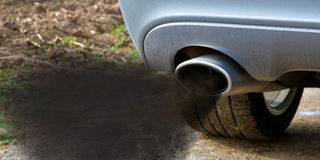What do you know about the exhaust?

Some car owners want noisy exhausts while others prefer quiet ones. PHOTO BY JUDE KATENDE.
The exhaust system on your car is probably the last thing on your mind, unless there is a loud rumbling sound from the rear of the car or something is dragging while you drive. The manufacturers, on the other hand, spend a lot of time and money putting those pieces of tubing beneath your car.
Deceptively simple, there are few parts to a complete system including manifolds, catalytic converter, muffler (that round exhaust thing usually located underneath the car at the rear), pipes, and hangers. In spite of this if it is not designed right or has a problem, your car drives like a brick and you’ll be spending a lot of time at the pump.
Modern exhaust systems need to do four things, that is, removing the exhaust gases from the engine as efficiently as possible, reduce the noise of the exhaust to tolerable levels, reduce harmful emissions in the gases, and direct the poisonous gases away from the passenger compartment.
Any series of pipes can direct the exhaust away from the passenger compartment, so this is the simple part. Getting those gases out efficiently is a challenge.
To create mechanical energy, the engine needs lots of air and fuel in the cylinders, but unless the exhaust gases are removed, the air/fuel mixture cannot get in. Most manufacturers use cast iron exhaust manifolds bolted to the engine to direct the exhaust gases out.
Some cars are using steel tube type manifolds to allow the exhaust gases to flow easier however they do have some drawbacks. Cast iron manifolds are easier to manufacture than steel tube ones, and their durability is very high.
Anyone who has driven long distances on the highway with steel tube manifolds can appreciate their quietness. That is if you care to notice. One last advantage of cast iron manifolds is their ability to hold heat.
Catalytic converters need to be hot before they start working to reduce emissions, so they are placed close to the engine so the exhaust gases can warm them up (somewhere in the range of about 316 degrees C). Cast iron manifolds keep the exhaust gases hot until they reach the catalytic converter, so the converter starts working quicker.
Converters have gone through several design improvements over the years. Honeycomb ceramic cores are coated with rare metals (platinum, palladium, and rhodium) to cause chemical reactions as the exhaust gases pass over them.
Today’s converters have more but smaller holes for the gases to pass through. Reactions occur faster and there is less restriction in the exhaust system.
The engine generates a lot of pulsating noise as its exhaust valves open up to release highly pressurised gas. These thousands of little sound bursts per minute travel quickly down the exhaust system and the noise bounces around to add up into a loud and potentially annoying sound.
The key, then, is to find a way to minimise this sound level before it exits the exhaust system. Enter the muffler. Some cars sound powerful others sound serene, so mufflers are designed for the image of the car.
There are many different types of mufflers out there, each suited to different performance and sound tastes.
Improving exhaust flow and performance is accomplished by designing a system with few corners in the pipes, less restrictive mufflers, and smooth transitions throughout the complete system.
So, there is much more to exhaust systems than meets the eye, just so you know. The faster your engine can get rid of exhaust gases, the faster it can take in air and generate more power. Therefore, efficient exhaust flow is essential to power output.




